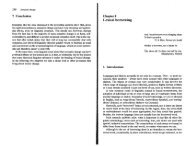Create successful ePaper yourself
Turn your PDF publications into a flip-book with our unique Google optimized e-Paper software.
<strong>Lexical</strong> <strong>and</strong> <strong>semantic</strong> <strong>change</strong><br />
15.<br />
16.<br />
17.<br />
18.<br />
19.<br />
20.<br />
21.<br />
22.<br />
23.<br />
24.<br />
25.<br />
26.<br />
Table 2.3<br />
Latin<br />
corpus<br />
ludaeu<br />
lege<br />
rege<br />
ripa<br />
rota<br />
auditu<br />
saccu<br />
succu<br />
necatu<br />
sabbatu<br />
abbas<br />
Basque<br />
gorputz<br />
judu<br />
lege<br />
errege<br />
erripa<br />
errota<br />
aditu<br />
zaku<br />
zuku<br />
nekatu<br />
zapatu<br />
apaiz<br />
Gloss<br />
'body'<br />
'Jew'<br />
'law'<br />
'king'<br />
'slope'<br />
'mill'<br />
'heard'<br />
'sack'<br />
(L) 'juice', (8) 'soup'<br />
(L) 'killed', (8) 'exhausted'<br />
(L) 'Sabbath', (8) 'Saturday'<br />
(L) 'abbot', (8) 'priest'<br />
of the time; note that Latin <strong>and</strong> invariably represent [k] <strong>and</strong> [g).<br />
The Basque forms are given in their modem st<strong>and</strong>ard form; note that<br />
Basque represents a voiceless sibilant [s]. What would you suggest<br />
might have been true ofthe plosive system in pre-Basque?<br />
Phonological <strong>change</strong> I:<br />
Change in pronunciation<br />
All types of <strong>change</strong> in pronunciation are collectively known as phonological<br />
<strong>change</strong>, or, using a more. traditional term, as sound <strong>change</strong>.<br />
Phonological <strong>change</strong> has been more intensively studied than any other<br />
type of language <strong>change</strong>; after nearly 200 years of scholarly investigation,<br />
we now know a great deal about the subject.<br />
Here I find it convenient to divide the study of phonological <strong>change</strong><br />
into two chapters, each looking at the subject from a different point of<br />
view. This first chapter deals with syntagmatic <strong>change</strong>: <strong>change</strong> in the<br />
sequence of speech sounds representing the pronunciation ofa particular<br />
word, or, more accurately, of groups of similar words. The next chapter<br />
will then go on to consider the consequences of such <strong>change</strong> for the<br />
phonological system of an entire language.<br />
As a result of this long tradition of study, syntagmatic <strong>change</strong>s have<br />
been classified into a number of different types, <strong>and</strong> these types have been<br />
given names in the form of technical terms. You will have to learn these<br />
terms, but fortunately the task is not difficult. The great majority of sound<br />
<strong>change</strong>s are phonetically natural: they are easy to underst<strong>and</strong> in terms of<br />
the structure <strong>and</strong> movements of the speech organs, <strong>and</strong> the terms which<br />
label various types of <strong>change</strong> mostly reflect rather directly what the<br />
speech organs are doing.<br />
3.1 The phonetic basis of phonological <strong>change</strong><br />
Ifyou are reading this book, you should already know something about the<br />
organs of speech, about the ways in which they are used to produce speech<br />
sounds, <strong>and</strong> about the conventional system for classifying <strong>and</strong> labelling<br />
meaningful sounds. For our purposes, the key point to remember is that the<br />
lips, the various parts ofthe tongue, the velum, the jaw, the larynx, <strong>and</strong> the<br />
glottis can be manipulated during speech in ways which are partly independent<br />
but also partly interrelated. For example, you can round your lips<br />
or not, regardless ofwhat the tongue is doing, but you can't round your lips<br />
tightly <strong>and</strong> keep your jaw lowered at the same time, nor can you produce a<br />
3 •.. 1 .....<br />
1<br />
I Ii



